Numbers from 51 to 100 Class 1 Notes Maths
| Table of contents |

|
| Numbers from 51 to 60 |

|
| Numbers from 61 to 70 |

|
| Numbers from 71 to 80 |

|
| Numbers from 81 to 90 |

|
| Numbers from 91 to 100 |

|
Numbers from 51 to 60
 The numbers from 51 to 59 are composed of five tens and one, two, three, four, five, six, seven, eight or nine ones respectively.
The numbers from 51 to 59 are composed of five tens and one, two, three, four, five, six, seven, eight or nine ones respectively.
Count, read and write the numbers. One is done for you.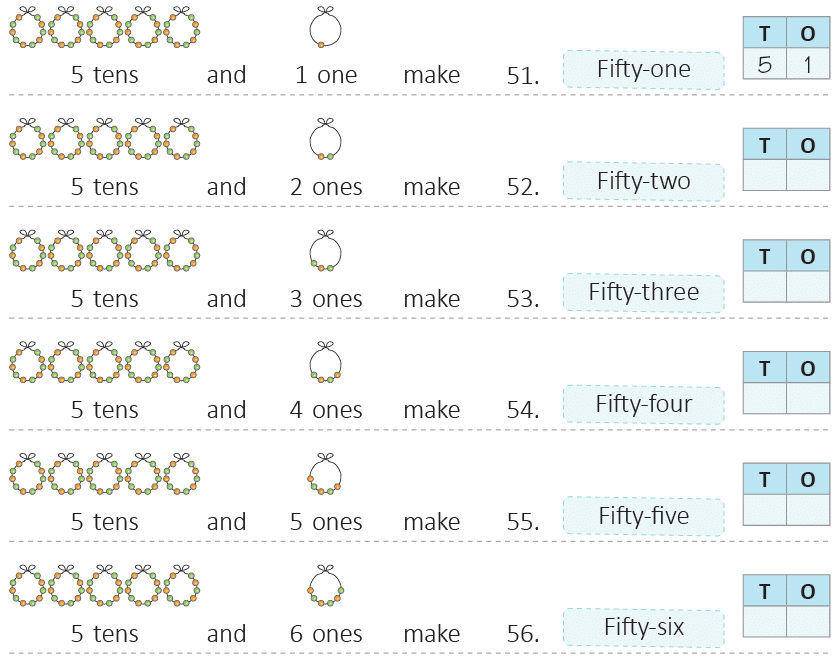


Numbers from 61 to 70
 The numbers from 61 to 69 are composed of six tens and one, two, three, four, five, six, seven, eight or nine ones respectively.
The numbers from 61 to 69 are composed of six tens and one, two, three, four, five, six, seven, eight or nine ones respectively.
Count, read and write the numbers. One is done for you.
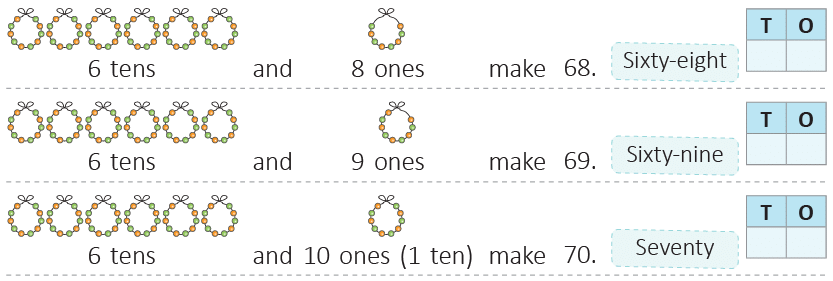
Numbers from 71 to 80
 The numbers from 71 to 79 are composed of seven tens and one, two, three, four, five, six, seven, eight or nine ones respectively.
The numbers from 71 to 79 are composed of seven tens and one, two, three, four, five, six, seven, eight or nine ones respectively.
Count, read and write the numbers. One is done for you.
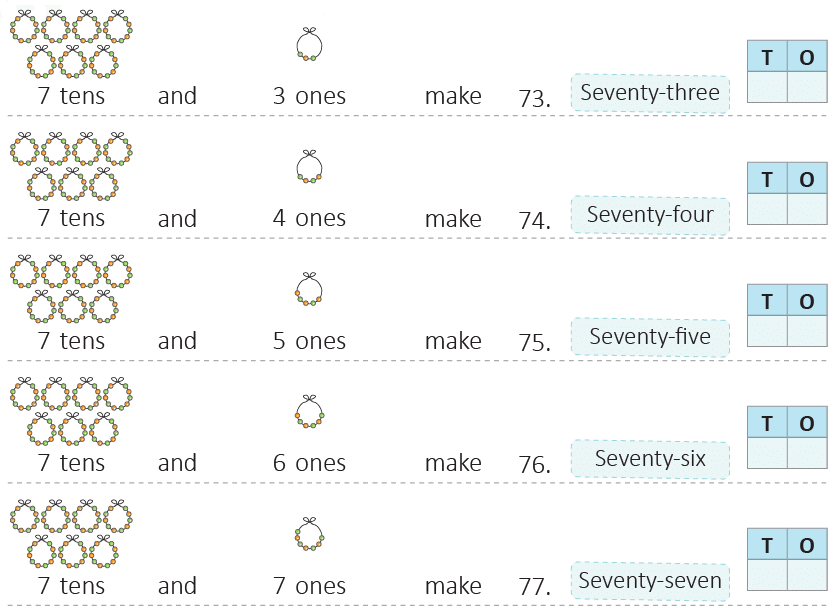

Numbers from 81 to 90
 The numbers from 81 to 89 are composed of eight tens and one, two, three, four, five, six, seven, eight or nine ones respectively.
The numbers from 81 to 89 are composed of eight tens and one, two, three, four, five, six, seven, eight or nine ones respectively.
Count, read and write the numbers. One is done for you.
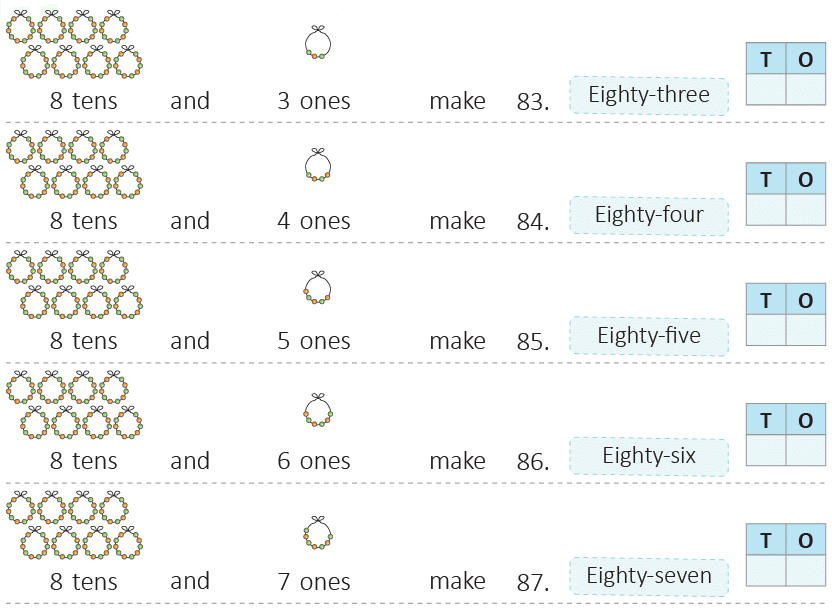

Numbers from 91 to 100
 The numbers from 91 to 99 are composed of nine tens and one, two, three, four, five, six, seven, eight or nine ones respectively.
The numbers from 91 to 99 are composed of nine tens and one, two, three, four, five, six, seven, eight or nine ones respectively.
Count, read and write the numbers. One is done for you.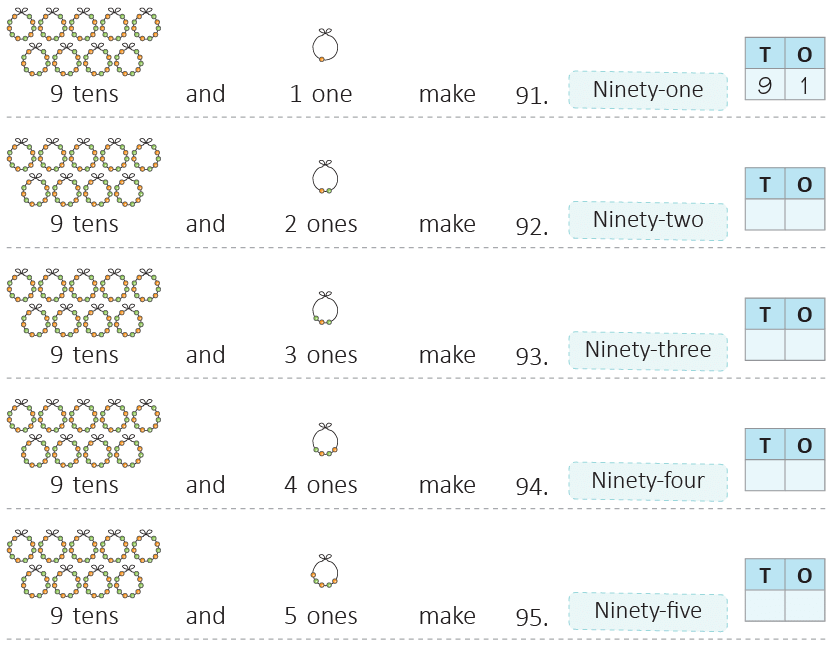


Before, Between and After

- The number just before is one less than the given number and the number just after is one more than the number itself.
- The number in between is one less than the next number and one more than the previous number.
Expanded Form
Aaisha to her father: Many a times, I think what makes a number? Digits! Father: It is not just the digits that make a number, it is the digits and their positions (places) within the number. Consider 25. If you interchange the positions of 2 and 5, you get 52.
Father: It is not just the digits that make a number, it is the digits and their positions (places) within the number. Consider 25. If you interchange the positions of 2 and 5, you get 52.
Aaisha: In 25, 2 is in the tens place, it means 2 tens or 20 and 5 is in the ones place, it means 5 ones or 5. I can expand 25 using tens and ones as 2 tens + 5 ones. 25 = 2 tens + 5 ones or 20 + 5 is the expanded form of 25. 25 is Watch Your Step! the standard form of the number twenty-five.
Comparing Numbers
Kaveri and Daksh are playing a video game. Kaveri got 47 points and Daksh got 32 points.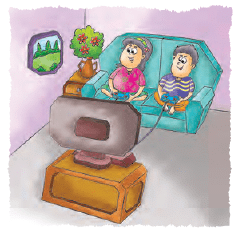 Kaveri: Yeh! I am the winner!
Kaveri: Yeh! I am the winner!
Daksh: How did you compare so fast?
Kaveri: I checked that 32 is on the left of 47 on the number sequence. So, it is smaller than 47.
We can also compare numbers by following two simple rules given below instead of counting one by one on the number sequence or checking the position of numbers on the number line (sequence).
Rule 1: A 2-digit number is always greater than a 1-digit number.
Example: 12 > 9 as 12 is a 2-digit number and 9 is a 1-digit number.
Rule 2: When both the numbers are 2-digit numbers.
(a) The number that has the bigger tens digit is greater.
Example:
33 > 26 as 3 (tens digit in 33) > 2 (tens digit in 26).
(b) If the tens digit is the same, compare the ones digits.
The number that has the greater ones digit is greater.
Example:
40 < 42 or 42 > 4U as U (ones digit in 40) < 2 (ones digit in 42).
Ascending and Descending Orders
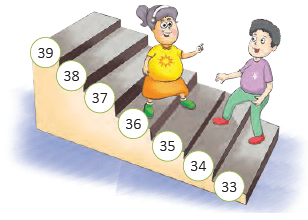 After learning which number is greater than another and which is smaller, we can easily put three or more numbers in order from the greatest to the smallest and from the smallest to the greatest.
After learning which number is greater than another and which is smaller, we can easily put three or more numbers in order from the greatest to the smallest and from the smallest to the greatest.
Ascending order of 33, 36, 49, 44, 11 is 11, 33, 36, 44, 49.
Descending order of 36, 33, 49, 44, 11 is 49, 44, 36, 33, 11.
|
15 videos|135 docs|23 tests
|
FAQs on Numbers from 51 to 100 Class 1 Notes Maths
| 1. What are the numbers from 51 to 60? |  |
| 2. What are the numbers from 61 to 70? |  |
| 3. What are the numbers from 71 to 80? |  |
| 4. What are the numbers from 81 to 90? |  |
| 5. What are the numbers from 91 to 100? |  |





















